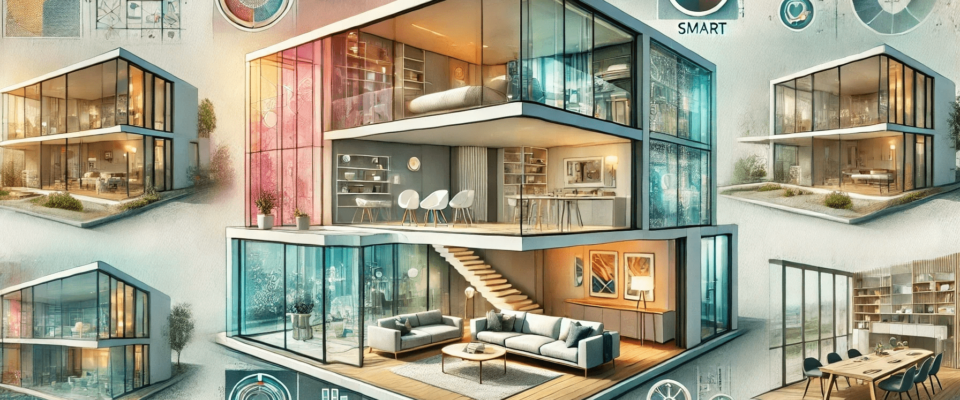The modern world of technology and innovation, actively penetrating every aspect of our lives, including housing, is increasingly integrating with nature, creating a unique harmony. We are already seeing how smart materials are becoming an integral part of our everyday life, improving its comfort and safety. Every day there are new developments that radically change our understanding of construction and interior design. It is these changes that will form the basis for discussing how the future of housing is being shaped today.
The evolution of building materials opens up new horizons in creating smart homes that adapt to the needs of their inhabitants. Such materials can automatically adjust the room temperature, reduce energy consumption, and even change their shape depending on external conditions. These innovations make it possible to create more sustainable and eco-friendly housing, providing comfort and safety to a whole new level. It is important to note that the harmonious combination of technology and natural elements makes these solutions not only useful, but also environmentally necessary. Smart materials become real active participants in the process of creatinga home, and not just building elements.
In the future, smart materials will play an even more significant role, becoming an integral part of any modern home. The latest technologies already allow us to create materials that can self-repair, purify the air and even generate energy. These developments significantly expand the capabilities of architects and designers, allowing them to create homes that not only meet people’s needs, but also make life more comfortable and safe.
Smart materials in construction
Smart materials are becoming a key element in creating modern homes, turning them into flexible and adaptive living spaces. These innovative materials have the ability to respond to changes in the environment, providing optimal living conditions. For example, some coatings can change color depending on the temperature or light level, creating a pleasant atmosphere in the room. This not only increases comfort, but also allows you to save energy, making the house more eco-friendly.
One of the most prominent examples of smart materials is self-cleaning coatings, which reduce the need for frequent cleaning and help maintain cleanliness. These coatings use innovative technologies that allow them to destroy dirt and germs when exposed to light or moisture. This solution not only makes life easier for home owners, but also contributes to maintaining the health of all residents. Self-cleaning coatings have become a real breakthrough in construction, making homes cleaner and safer.
The future of smart materials in construction promises even more amazing developments that will completely change the way we think about housing. Materials that are able to recover from damage or adapt to climate change no longer seem like something fantastic. These innovations will not only improve the quality of life, but also help create a more sustainable and environmentally friendly architecture. The introduction of such materials will be an important step towards creating the homes of the future, which will be not just housing, but intellectual partners in our daily lives.
Integrating smart materials into interiors
The integration of smart materials into interior solutions can significantly increase the functionality and aesthetic appeal of modern homes. New technologies offer unique opportunities to create a space that not only meets the requirements of comfort, but also actively participates in ensuring the well-being of residents. Such materials can change their properties depending on the time of day or the activity of people in the house. For example, surfaces that can change texture or color can adapt to the mood or needs of their owners.
To better understand the capabilities of smart materials, we can distinguish the following main types:
- Heat-sensitive coatingsthat respond to ambient temperature.
- Soundproof panelsthat provide a high level of acoustic comfort.
- Photochromic glassesthat change their transparency depending on the light.
The use of these materials opens up new horizons for designers to create dynamic and flexible interiors. Such innovations not only simplify space management, but also contribute to improving the quality of life. As a result, smart materials become not just a part of the interior, but its active element, which allows you to create a harmonious and adaptive space for living.
The future of interiors with smart materials promises even more opportunities to personalize your living space. Modern technologies already allow you to integrate elements that respond to changes in mood or external factors into the interior. Such solutions create a sense of close connection between a person and their home, enhancing the emotional perception of space. This makes smart materials an integral part of both the external and internal environment, which completely changes our approach to the concept of”home”.
Smart windows and facades
Smart windows and facades play an important role in creating energy-efficient and comfortable homes. These innovative elements allow you to adjust the amount of light and heat entering the room, automatically adapting to the external environment. This can significantly reduce energy consumption for heating and air conditioning. Such solutions are alreadybecoming the standard in the construction of modern buildings, ensuring their environmental and economic efficiency.
Modern technologies allow you to integrate smart glasses that can change their transparency or reflectivity depending on the level of solar activity. These panes help maintain an optimal indoor climate, preventing overheating in summer and keeping you warm in winter. Smart facades equipped with sensors and automation can change their shape or open vents to improve air circulation. Thus, they not only improve energy efficiency, but also increase the overall comfort of living.
In the near future, smart windows and facades will become even more interactive and functional, offering solutions that take into account not only weather conditions, but also individual preferences of residents. These technologies will make homes even more adaptive, creating ideal living conditions at any time of the year. Ultimately, smart facades and windows will be an important element in creating sustainable and comfortable living spaces of the future.
Smart coatings and insulation materials
Smart coatings and insulation materials represent another important component of modern smart homes. These materials not only provide reliable protection from external factors, but also actively participate in maintaining a comfortable indoor microclimate. For example, self-cleaning coatings significantly reduce home maintenance costs. They also help prevent mold and mildew, making the home healthier and safer to live in.
Innovative insulation materials used in the construction of smart homes provide high energy efficiency, allowing you to minimize heat loss in the cold season and keep cool in the summer. These materials can change their properties depending on external conditions, adapting to changes in temperature and humidity. These technologies not only make homes more comfortable, but also help to significantly reduce energy costs.
In the future, the development of smart coatings and insulation materials will be aimed at improving their functionality and durability. New developments will include materials that can recover from damage and adapt to changing operating conditions. This will make it possible to create homes that will not only be comfortable to live in, but will also be able to independently maintain their operational characteristics for many years.
Questions and answers
Smart windows and facades are building elements that adapt to external conditions by regulating light and heat.
They reduce energy consumption for heating and cooling by regulating heat transfer and insulation.
It is expected to develop interactive materials that will adapt to the individual preferences of residents.

